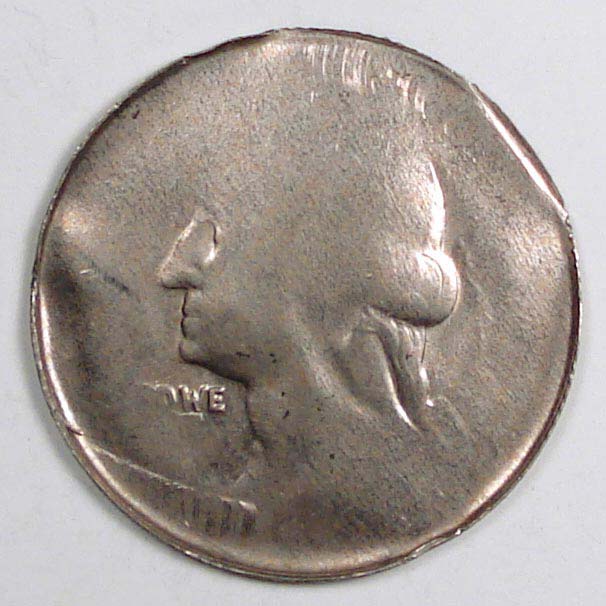Major error eye candy #9: Clad layer split before strike
On type of middling-common error on clad coinage is when a clad layer splits off entirely, resulting in a struck clad coin with one side showing bright red copper.
In the two examples here, I'm showing "the rest of the story" -- the clad layer itself, that split off before the strike. The first of these was obviously split before the strike, since it is die struck on both sides. The second one is less obvious. I'm saying that it was split before the strike because it exihibits a good chunk of the reeding around almost half of the circumference. I think it split first, and then was struck against another planchet. The other planchet would have received a "struck through clad layer" strike, showing a weak image of the reverse except that this 100% strikethrough would be indistinguishable from a capped die strike.
Both of these examples are very light at 0.950 and 0.962 grams, about one-sixth of the 5.67 grams of a normal quarter.




Earlier:
Major error eye candy #1: Edge strike, double struck
Major error eye candy #2: 125% struck through cloth
Major error eye candy #3: Struck through feeder finger
Major error eye candy #4: 1955 Double Date Lincoln Cent
Major error eye candy #5: Nonface strikes
Major error eye candy #6: Reeding struck through coin
Major error eye candy #7: Broadstrike with partial counterbrockage
Major error eye candy #8: Incomplete clip mystery dime?
In the two examples here, I'm showing "the rest of the story" -- the clad layer itself, that split off before the strike. The first of these was obviously split before the strike, since it is die struck on both sides. The second one is less obvious. I'm saying that it was split before the strike because it exihibits a good chunk of the reeding around almost half of the circumference. I think it split first, and then was struck against another planchet. The other planchet would have received a "struck through clad layer" strike, showing a weak image of the reverse except that this 100% strikethrough would be indistinguishable from a capped die strike.
Both of these examples are very light at 0.950 and 0.962 grams, about one-sixth of the 5.67 grams of a normal quarter.




Earlier:
Major error eye candy #1: Edge strike, double struck
Major error eye candy #2: 125% struck through cloth
Major error eye candy #3: Struck through feeder finger
Major error eye candy #4: 1955 Double Date Lincoln Cent
Major error eye candy #5: Nonface strikes
Major error eye candy #6: Reeding struck through coin
Major error eye candy #7: Broadstrike with partial counterbrockage
Major error eye candy #8: Incomplete clip mystery dime?
0
Comments
<< <i>It's often very difficult to distinguish a split-after-strike clad layer from a split-before-strike clad layer that was struck against an unstruck planchet. I can't make the determination in this case. >>
Aren't these errors basically the same thing? A clad layer that is only attached to the rest of the coin by a small hinge of metal struck against the host planchet (split after strike) and clad layer struck against a planchet (split before strike) would be one and the same in my opinion.
an outer clad layer that split off Before it was struck.
The lower coin was split off After it was struck;
somewhere there should be a Quarter with the
Copper core showing on the reverse, with a 'ghost'
image of the eagle.
Both types, I've found, are much scarcer to find
compared to either an Obv. or Rev. Clad Layer Missing
coin.
The one's struck ON the detached shell (detached before
strking) are my favorite of this type, and are scarcer
than the Detached After Striking type......